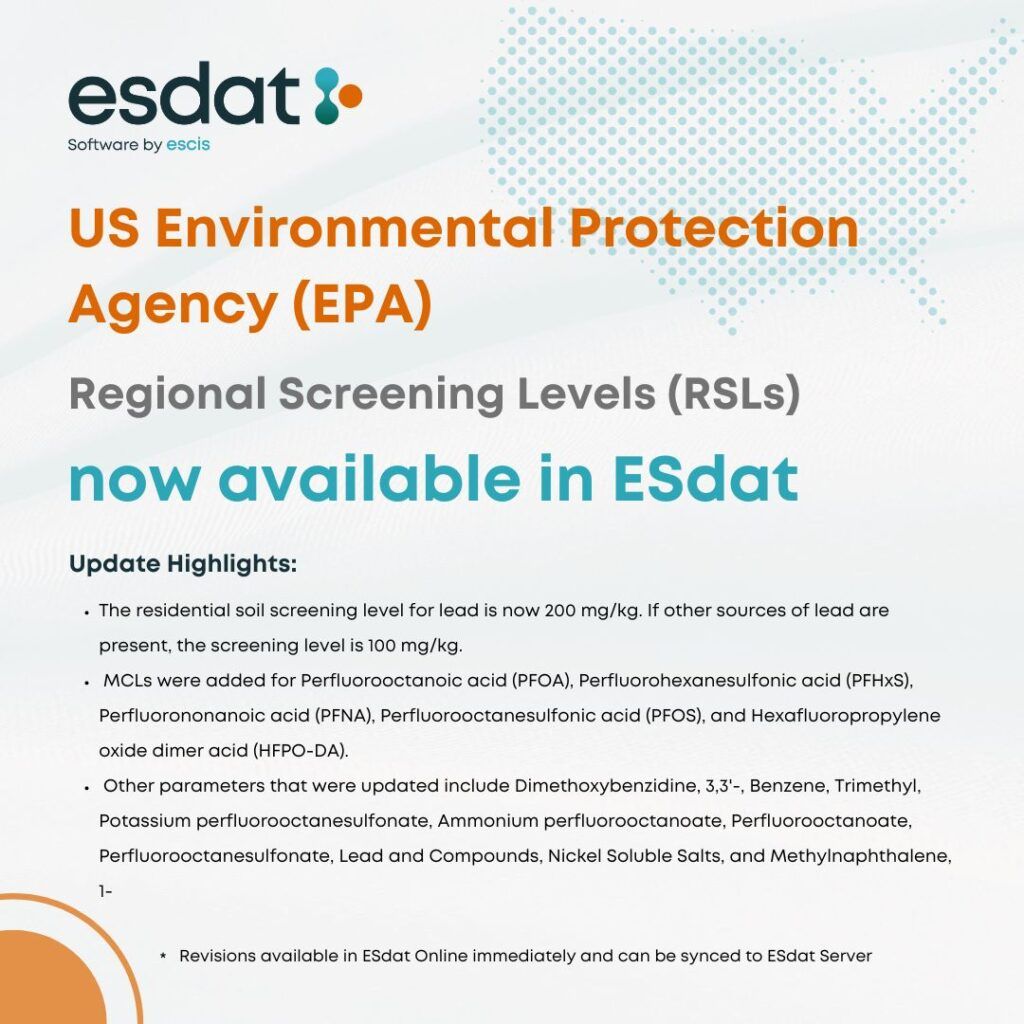We’re excited to announce that the updated USEPA Regional Screening Levels (RSLs) are now available in ESdat.
The residential soil screening level for lead is now 200 mg/kg (100 mg/kg if other lead sources are present). MCLs have been added for various compounds, including PFOA, PFHxS, PFNA, PFOS, and HFPO-DA. Updates include changes to parameters like Dimethoxybenzidine, Benzene, Trimethyl, Potassium perfluorooctanesulfonate, and more.
These updates ensure access to the latest standards, helping you stay compliant and informed. Revisions are available in ESdat Online immediately and can be synced to ESdat Server.

What are U.S. EPA Regional Screening Levels (RSLs)?
The U.S. EPA Regional Screening Levels (RSLs) are risk-based concentration levels used by the EPA to evaluate potential human health risks from chemical contaminants at contaminated sites. They are used as initial screening tools to help determine whether further investigation or remediation is necessary at a site. If concentrations of contaminants in environmental media (e.g., soil, air, water) are below the RSLs, it generally suggests that the site is not expected to pose significant health risks.
Here’s a breakdown of key aspects of RSLs:
1. Purpose of RSLs
• Screening Tool: RSLs serve as conservative risk-based values to help environmental professionals screen contaminated sites. These levels help assess whether contaminant concentrations in air, soil, or water are likely to pose health risks to humans.
• Preliminary Evaluation: RSLs are used during the initial stages of site assessments to determine if further, more detailed risk assessments or remediation efforts are needed.
2. Calculation of RSLs
• RSLs are based on established risk assessment methodologies, using data about chemical toxicity, exposure scenarios (e.g., residential or industrial land use), and safety factors. They consider both carcinogenic and non-carcinogenic risks.
• The levels are derived from target risk levels (e.g., an excess cancer risk of 1 in 1,000,000) and hazard quotients (typically set at a value of 1) for non-carcinogens.
3. Media
RSLs apply to contaminants in various environmental media:
• Soil: Levels for both residential and industrial scenarios are provided.
• Groundwater: RSLs are used to assess potential risks from contaminants in drinking water.
• Air: Air screening levels help assess risks from airborne contaminants, particularly in industrial settings.
4. Risk Scenarios
RSLs are typically calculated for:
• Residential exposure: Assumes long-term exposure (e.g., 30 years) to chemicals in a home setting, including exposure routes like ingestion, inhalation, and dermal contact.
• Industrial exposure: Assumes exposure in a workplace setting, typically over an 8-hour workday and a 25-year career.
5. Limitations
• Not Regulatory Standards: RSLs are not enforceable cleanup standards but are used as benchmarks for screening. If contaminant levels exceed the RSLs, further evaluation is needed, but exceeding an RSL does not automatically mean a site poses a health risk.
• Conservative Approach: RSLs use conservative assumptions to protect sensitive populations, such as children or individuals with pre-existing health conditions.
6. Updates and Regional Use
• RSLs are updated periodically to reflect new toxicological data and advancements in risk assessment.
• Although they are called “regional” screening levels, they are developed at the national level and are available for use across all EPA regions.
Related Articles to US EPA Regional Screening Levels
What are Regional Screening Levels EPA RSL 1.0 and EPA RSL 0.1?






